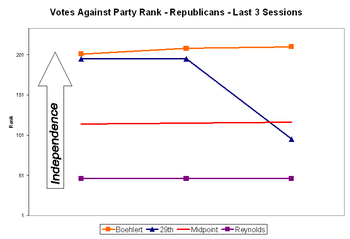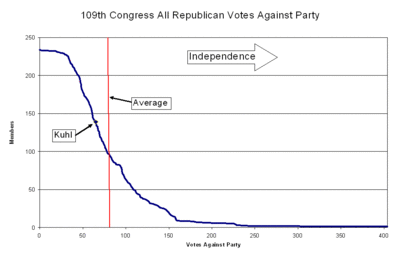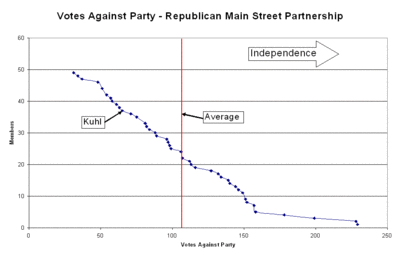Kuhl vs Houghton on Independence
Thu, 09/21/2006 - 22:12 — RottenchesterAmo Houghton, the previous holder of the 29th's seat in Congress, is considered an independent, centrist Republican. He voted against the war in Iraq and was one of the founders of the centrist Republican Main Street Partership. Let's compare his voting record with self-proclaimed "Independent" Randy Kuhl.
Using data from the last three sessions of Congress, I ranked Kuhl and Houghton against their peers in the Republican party on a simple independence metric: the number of times that each voted against the majority of their party.
In the 108th and 107th Congress, Amo Houghton voted against his party 16% and 20% of the time, respectively. So far in the 109th, Randy Kuhl has voted against party 9%.
This graph plots the relative independence of the 29th seat in the last three Congressional sessions, and compares it to some other New York Republicans. The top line is retiring Rep Sherwood Boehlert, NY-24, a moderate Republican. The bottom line is Rep Tom Reynolds, NY-26, who's considered a party loyalist. The red line represents the "middle of the road", and the blue line is the 29th. As you can see, in Kuhl's freshman term, the 29th went from being quite independent to being one of the more reliable party votes.
Again, Kuhl's slogan -- "Accessible, Independent, Effective" -- is suspect when you go by the numbers.
-----
Notes on the data: For the 109th, this report used the dataset
of votes created by professors Jeff Lewis and Keith Poole, and
limits votes to those taken prior to September, 2006. The 108th and 107th use Poole's voteview datasets. Any errors here
are mine, not theirs.
Massa Interview
Thu, 09/21/2006 - 07:57 — RottenchesterDragonFlyEye has posted an in-depth interview with Eric Massa. He asks some good questions, especially about Massa's positions on free trade. This kind of interview is citizen journalism at its best.
Hillary's Robo-Call
Wed, 09/20/2006 - 19:57 — RottenchesterI just received a robo-call from Hilary Clinton. The call included a statement about Democrats "taking back the House". The call tried to collect three things: whether I was willing to volunteer, whether I intended to vote, and my email address. It sounds like the start of Hilary's promised GOTV campaign.
More Bad Cheney PR
Wed, 09/20/2006 - 16:32 — RottenchesterThe Cheney visit was mentioned again in today's paper Democrat and Chronicle, and in the Messenger-Post. That latter story is awful for the Kuhl campaign, since it concentrates on a Kuhl vs.the Democrats catfight about whether the visit is a secret.
As usual, where there's bad PR for the Kuhl campaign, campaign manager and son James Kuhl isn't hard to find. James is a central figure in the M-P article. First, he denies that the visit was kept a secret, then he says:
he hadn't formally notified the media of the event "because we were instructed not to confirm the vice president's attendance."
Well, when the VP comes to town for your campaign and you don't issue a press release, you might not be keeping his visit a secret, but you're certainly downplaying it.
You're also leaving yourself open to letting your opponent frame the debate. Every story I've seen on the fundraiser has the cost of tickets and photo-ops front and center, because every story starts with the Massa campaign press release. If the Kuhl campaign had issued a release about Cheney's visit first, they'd be able to frame the fundraiser in a more positive light. Because Cheney is such a polarizing figure, that positive spin might not have stuck, but at least the first stories would not have been based solely on the words of Kuhl's opponent.
Measuring Kuhl's Independence
Wed, 09/20/2006 - 15:10 — RottenchesterLike all good political advertising, Randy Kuhl's new tag line -- "Accessible, Independent, Effective" -- sounds good and is hard to measure.
"Accessible" and "Effective" are subjective: Accessible to whom? Effective at what? I'll leave it to the reader to decide whether those components of Kuhl's slogan is true for them.
"Independent" is a little less tricky, because we can use the facts of Kuhl's voting record to measure it.
One common measurement of Kuhl's record is the claim that he votes with President Bush 93% of the time, which makes it sound like they're joined at the hip. But Congress votes a lot (the 109th has more than 1100 recorded votes), and most of those votes are for relatively minor, uncontested issues, like the naming of post offices or resolutions against cancer. Kuhl could argue, with some justification, that 93% isn't as close to Bush as it sounds.
Instead of an absolute percentage, let's compare Kuhl's votes to House Republicans in general. Kuhl's aso a member of the Republican Main Street Coalition, a centrist group that includes independents like John McCain in the Senate and fellow New Yorker Sherwood Boehlert in the House. Since Kuhl's predecessor Amo Houghton was a founding member of the coalition, it's worth seeing if Kuhl is keeping up the tradition of independence that this group represents.
The following graphs measure Kuhl's performance within these two peer groups. The horizontal (X) axis is the number of times a member has voted against the majority of his or her party. The vertical axis is the cumulative number of members who have a given number of "contrary" votes. Kuhl's position is clearly marked.
Another way of looking at these graphs is that the "pack" is on the left and the "rebels" are on the right. The farther right a member is plotted on the graph, the more independent (against the pack) they are.
This first graph shows where Kuhl stands in relation to the rest of Republicans. The red line represents the average number of times that a Republican votes against his or her party: 83 times. Randy Kuhl's 65 votes against the majority is well under that number. By that measure, he's less independent than average.
The second graph plots Kuhl's standing among the 49 members of the Republican Main Street Coalition. Kuhl's 65 contrary votes is far below the group average of 106. Kuhl's standing here is well within the bottom third of Main Street members.
The conclusion I draw from these numbers is that Kuhl's claim of independence is suspect at best. He votes with his party more than average, and far more than the average of a self-identified group of independents. In fact, in the New York Republican delegation, Kuhl is second only to Tom Reynolds in party loyalty.
-------------
Notes on the data: This report used the dataset of votes created by UCLA professors Jeff Lewis and Keith Poole, and limits votes to those taken prior to September, 2006. Any errors here are mine, not theirs.
VFW Endorses Massa
Tue, 09/19/2006 - 18:15 — RottenchesterThe Veterans of Foreign Wars (VFW) Political Action Committee has endorsed Eric Massa. This is interesting for a few reasons. First, in 2004, the PAC made no endorsement in the 29th race. Second, the VFW-PAC has a history of party-neutral support. Finally, the VFW endorsement again rubs the district sore spot of the Canandaigua VA Hospital. So, unlike Eliott Spitzer's endorsement of Massa, which also occurred today and was nothing if not expected, the VFW endorsement is actually news.
Debates
Mon, 09/18/2006 - 15:58 — RottenchesterThe Kuhl campaign has announced four debates, of which three have apparently been agreed to by the Massa Campaign:
- "Debate 1" is in Canandaigua on October 5, sponsored by the Messenger-Post newspaper and the Canandaigua Rotary Club.
- "Debate 2" is in Elmira on October 10, sponsored by WETM (a NBC affiliate in Elmira) and the Corning Leader.
- The third debate is in Bath on October 11, and is sponsored by the League of Women Voters.
- The fourth debate, which according to Kuhl hasn't been confirmed by the Massa Campaign, is on the WLEA radio station in Hornell.
- (Update) The fifth debate is October 16 at 7:00 p.m. on RNews, the Rochester Time-Warner Cable news channel.
On the Ground
Mon, 09/18/2006 - 08:42 — RottenchesterYesterday the town of Pittsford had a community celebration. Pittsford is an affluent, mainly Republican suburb in the North end of the 29th. The town supervisor, county legislator, state senator and assemblyman are all Republicans.
I was there for a couple of hours and saw Eric Massa and over a dozen residents wearing Massa t-shirts, as well as Massa flyers on every table. There was no Kuhl presence - no flyers, no signs, nothing. With less than two months remaining in the campaign, I found that surprising.
Will the Unions GOTV?
Mon, 09/18/2006 - 07:41 — RottenchesterToday's Binghamton paper covers the role of unions in New York's close congressional elections. The national AFL-CIO has a $40 million warchest, and they plan to spend some of it on races in New York's 20th and 24th districts. The 29th would get union attention only if the race appears to be close.
Kuhl's New Ad
Sun, 09/17/2006 - 13:06 — RottenchesterRandy Kuhl's new ad is a positive, first-person accounting of federal money spend in the district. It also introduces a new campaign tag line: "Accessible, Independent, Effective: Congressman Randy Kuhl". Here it is:


